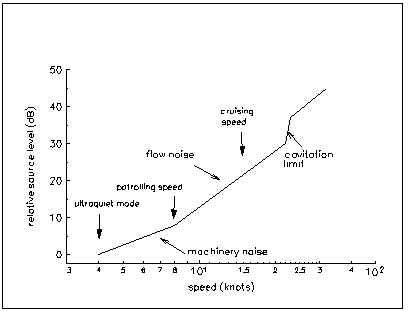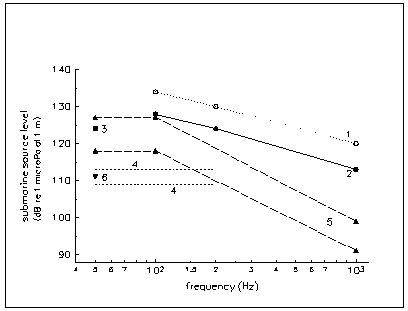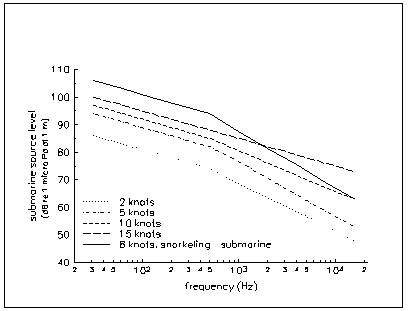
Appendix 1 E.V. Miasnikov, The Future of Russia's Strategic Nuclear Forces: Discussions and Arguments,
A moving submarine(21) is source of noise by whose characteristics it is possible not only to detect it against the background of the ocean's natural noises, but also reveal its location, speed and, generally speaking, identify it. Several mechanisms for noise radiation from the submarine exist, which are more or less prevalent depending on the frequency band, speed and depth of the submarine. Among these mechanisms are hull vibration, power plant equipment, propellers and flow noise (hydrodynamic noise).
The submarine's noise level or source level (SL) is the intensity of sound in a given frequency band at a distance of one 1 meter from the submarine within a receiver's direction.(22)
In practice, SL is measured in logarithmic units or decibels (dB) in relation to a standard intensity. The Russian Navy generally takes the standard to be the threshold for audibility (a plane sound wave of an intensity 20 Pa). In the American Navy SL is defined at a distance of 1 yard (1 yard = 0.914 m) relative to the source intensity of 1 Pa. The quantitative significance of SL, defined by the Russian and American systems in one or the other frequency bands, will differ by 27 dB.
As a rule, the following regularities in the behavior of the noise spectrum of submarines are observed.
The SL frequency of the spectrum constitutes a mixture of the continuous and discrete ("linear-frequency") spectrum. The continuous part of SL spectrum is characterized by a maximum in the area of 50-100 Hz. At frequencies greater than 200 Hz SL falls by 6 dB when the frequency is doubled. This means that SL is inversely proportional to the square of the frequency.
The discrete components are the most visible signs of the submarines' SL spectrum since they are detected even at low speeds, when submarines produce minimal noise. Moreover, the aggregate of the discrete components of the noise spectrum (the so called "acoustic portrait") which is unique for each submarine, may be used to identify the source.
Discrete lines in the 0.1-10 Hz band are caused by rotation of the propellers. This noise is difficult to suppress. Moreover, the noise from the propeller may be heard in the ocean at a distance of up to several thousand kilometers since absorption by ocean waters at this low frequency is negligible. The method of narrow-band filtration of the spectrum's discrete line at frequencies up to several Hz is the basic working principle for sonar systems for long-distance detection.
Discrete lines in the frequency band of several Hz to several hundred Hertz is associated with vibrations from the submarine's hull and power plant equipment. The most characteristic line in the SL spectrum is the peak at frequencies of 50 and 60 Hz for Russian and American submarines respectively, i.e., the lines which correspond to the basic frequencies of the submarines electric generators. The SL spectrum of first generation SSNs contained discrete lines at frequencies, which are multiples of 50 and 60 Hz, or in other words, harmonics of the basic frequencies. Specialists claim to have successfully registered up to 5 harmonics of basic frequencies. The spectrums of modern fourth generation submarines, those built at the end of the 1980's, do not contain discrete lines at frequencies greater than 100 Hz. This is justified to a lesser degree when the speed is less than 8 knots [Gorbachev, 1994].
Table A1. A model of a SL spectrum of submarines
| SL component of the spectrum [relative to 1 Pa at 1 m] | Spectral strength of SL in a frequency band (1Hz) [relative to 1 Pa at 1m] | |
|---|---|---|
| 5-200 Hz | 1kHz | |
| "Noisy" Submarine | 140 | 120 |
| "Quiet" Submarine | 120 | 100 |
| "Very quiet" Submarine | 100 | 80 |
These peculiarities of a submarine's SL spectrum make it possible to describe them by two parameters, namely, SL at a frequency of 1 kHz and the energy of the most powerful discrete components in the frequency band of 5-200 Hz. Table A1 shows a model of a submarine's SL using these parameters.(23)
Commenting on Table A1, we stress that the estimates which were put forth relate to movement at small submerged speeds of nearly 4 knots (2 m/s) with the limited use of the working mechanisms (the so called "ultraquiet operation" mode). In this mode the basic sources for noise are the submarine's propellers and the power plant equipment.
The "ultraquiet " mode is used by submarines only as needed. The submarine's speed on combat patrols generally does not exceed the so called "maximum low noise" speed which amounts to nearly 8 knots (4 m/s). The source level at this speed may exceed SL at a "quiet" mode by 5-10 dB (see Figure A1)
Often, to complete their assigned missions, submarines have to carry out long distance voyages. Russian and American SSNs travel distances of several thousand miles to patrol zones. In order to increase their operational efficiency,(24) submarines in transit move at a maximum speed which guarantees the submarine covertness. Generally this speed does not exceed 15 knots (7.5 m/s). At this speed the flow noise (so-called hydrodynamic noise) predominates. The flow noise strongly depends on the submarine's speed, and generally the SL is proportional to the speed raised to the sixth power. This means that doubling the speed will increase SL by 18 dB. It has been suggested that a submarine in transit is 15-20 dB noisier than one in the "quiet" mode.
It is also necessary to note that the noise level of a specific submarine doesn't remain constant. During their service life, submarines wear out and their mechanisms become unbalanced. It is the opinion of specialists that during its operational life, the noise level of submarines grows on average by 5 dB.
Although the program for building submarines was, after the second world war, given priority in both the US and the USSR, the American shipbuilders essentially left the Russians behind on the issue of ensuring the covertness of submarines. During the 1960's subjective factors caused the lag. The Russian Navy was more interested in high speed submarines than in covert ones. [Parkhomenko, 1993].
The second generation of Soviet submarines was less noisy, but progress in decreasing the SSBN signature was achieved by the Soviet shipbuilding industry only during the 1980's with the appearance of the strategic submarine design 667 BDRM. During this period new technologies were introduced which resulted in an order of magnitude improvement in the accuracy of manufacturing gears for the main turbine gear assembly, shafts and propellers. A significant decrease in noise level was also achieved with the application of active noise suppression methods for submarines.
The main reason was that Russia lagged behind the US in manufacturing technologies. In particular, according to specialists' testimony, improving the tolerance for the size of a tooth gear on the submarine's main turbine gear assembly (GTZA) by 0.1 to 0.01 mm permitted a reduction of the submarine's SL by 3-4 orders of magnitude (30-40 dB).
Nevertheless, there existed objective causes which, in principal, limited the possibilities for domestic shipbuilding. As opposed to American SSBNs, Russian SSBNs are double-hulled, with double reactors and double shafts. This design guarantees great reliability, but, inevitably, at a sacrifice to the submarine's covertness. [Parkhomenko, 1993]. Russia's sea-based ballistic missiles differ from American missiles by their greater dimensions and correspondingly larger weight. As a result, the displacement of domestic strategic submarines became larger despite a smaller number of missiles being accommodated.(25)
Quantitative data on the actual noise levels of combat submarines is highly classified. However, an analysis of the available unclassified technical literature permits us to estimate their noise level.
In particular, information on the noise level of diesel submarines during the Second World War has been published. [Urick, 1983]. This generation of submarines may be referred to as "noisy" since at low frequencies, SL exceeded 125-145 dB at speeds of 4-10 knots (2-5 m/s).
Some estimates of the noise level of diesel-electric submarines from the 1960's-1980's were also made by participants of the Russian-American conference on anti-submarine warfare in coastal waters (see Figure A1.2). Although the regimes, from which these noise characteristics were taken are not, as a rule, specified by the authors, nevertheless it may be proposed that the data is related to submarines (PL) working in "ultraquiet" modes. In particular, according to the supplied estimates, SL of the diesel 887 design (Kilo) submarine conforms with "quiet" submarines.
Figure A1.3 shows the noise spectrum for a diesel submarine from one of the designs developed during the 1980's by the German company IKL. This chart corresponds well to the assumptions made in this article on the character of the noise spectrum and on the dependence of source levels on the submarine's speed. It is easy to see that with speeds corresponding to 2 and 5 knots (1 and 2.5 m/s), the SL of a diesel submarine is also located within the "quiet" submarine range.
Information on the noise level of nuclear submarines is practically non-existent in the open literature. However, specialists have repeatedly said that the noise level of a nuclear submarine is higher than that of a diesel submarine running on batteries.(26)
This fact may be explained by several reasons. First, like a diesel submarine, a nuclear submarine may work at a minimal speed, running off the storage cells (batteries). However, the submarine's nuclear reactor continues working and this is an additional source of noise. Second, the displacement for nuclear submarines usually exceeds, by several times, the displacement of diesel, and this requires a greater power to weight ratio. In our calculations we made the assumption that within a "quiet" mode the difference in noise level between strategic nuclear submarines and diesel submarines, which were developed at the same time, is 10 dB.
There is still one assumption that we made which was associated with the source level at discrete frequencies and at a frequency of 1kHz within a given noise spectrum for a submarine. As shown by the analysis of SL of diesel submarines, the energy of the most powerful discrete components of the spectrum exceeds the energy in the 1Hz band at a frequency of 1 kHz by nearly 20 dB. This is probably the pattern followed by noise spectrums of nuclear submarines.
Table A2 shows estimates of SL of domestic strategic submarines. These estimates were published for the first time by the author of the present work in the article "On the covertness of Russian submarine cruisers" (Military Journal, Bulletin Postfactum, #21, 1994, p.6-9). [Also published as "Russia's Strategic Ballistic Missile Submarines: Security from Detection," Military Journal, Postfactum analytical Series, N 21, 1994, p. 5-7] The data in the present table differs somewhat from that previously published. We suggest that the noise level of first and second generation SSNs were somewhat too high.
The noise levels of first generation Soviet missile submarines (designs AV-611, 629), evidently, were of the same magnitude as submarines from the Second World War.(27)
The diameter of the propellers of these submarines were relatively small, so even at low speeds the submarines worked in a noisy cavitation mode. It is also well known that submarines with first generation ballistic missiles were not specially developed for accommodating these missiles.
Missile submarines were actually torpedo submarines with missile compartments "cut into them." Decreasing the noisiness of submarines was not at that time the basic criteria when planning submarines. Incidentally we note that our estimate of 5-10 dB exceeds the SL of the 641 design submarine (see figure A1.2) which was developed at the end of the 1950's.
The 658 missile SSBN (Hotel) was developed practically in parallel with the 629 submarine (Golf). There was very little experience in operating nuclear power plants. The lead submarine of this series of 658s joined the service at the end of 1960 - two years after the first Soviet SSN "K-3" had been tested. Therefore, the difference in SL of 10 dB compared to the 629 design missile submarine seems sufficiently "reasonable."
Table A2. Estimates of the noise level of Russian SSBNs
| design number | SL discrete frequencies in 5-200 Hz spectrum (dB relative to 1 Pa at 1m) | SL, 1kHz (dB/Hz relative to 1Pa at 1m) | Submarine speed | |
|---|---|---|---|---|
| AV-611 | (Zulu V) | 130-135 | 110-115 | 2 economical speed |
| 629 | (Golf) | 130-135 | 110-115 | 2 economical speed |
| 658 | (Hotel) | 140-145 | 120-125 | 4 |
| 667 A | (Yankee) | 135-140 | 115-120 | 4 |
| 667 B | (Delta I) | 130-135 | 110-115 | 4 |
| 667 BD | (Delta II) | 130-135 | 110-115 | 4 |
| 667 BDR | (Delta III) | 125-130 | 105-110 | 4 |
| 941 | (Typhoon) | 125 | 105 | 4-8 |
| 667 (BDRM | (Delta IV) | 120 | 100 | 4-8 |
| for comparison: | ||||
| 971 | (Akula) | 110 | 90 | 4-8 |
We assume that, as a rule, the noise levels of each newly designed SSBN decreases by 5 dB in comparison with the previous. Nevertheless, certain exceptions were made. It is probable that the SL of the 667 B (Delta) strategic missile carrier and the 667 BD (Delta II) were comparable. This is in spite of the fact that the 667 BD (Delta II) nuclear submarine was developed 3 years later and it had a larger displacement.
There were also differences in the size of the displacement and power to weight ratio of the 667 BDR (Delta II) and 941 (Typhoon) strategic missile submarines. Although in the open literature it is noted that after entering into the Navy's service the heavy SSBNs 941 design (Typhoon) was the quietest strategic submarine [Kostev, 1994], we suggest that its SL coincided with the lower noise boundaries of the strategic SSBN design 667 BDR (Delta III).
We notice that our estimates of SL for the 941 (Typhoon) and the 667 BDRM (Delta IV) missile submarines are 8-13 dB higher than the diesel-electric 877 (Kilo) submarine which was developed at the same time.
Table A2 shows for comparison SL estimates, made by specialists, of the SSN 971 (classified by the Russian Navy as "Bars" and by NATO as "Akula") which is currently in production. In the West it is believed that these submarine significantly surpass the covertness not only of previous generation Russian SSNs, but also modern American SSNs [Gertz, 1995]. Probably, if a new generation of Russian strategic missile submarines will be built, they will not be much noisier than the SSN "Bars".



Bibliography for Appendix 1
[Voronin, 1995] G.P. Voronin, "The Silence of our submarines annoys not only dilettantes," Krasnaya Zvezda, 28 January 1994, p.5
[Gertz,1995] Bill Gertz, "The Russian Akula observed off the US' shores," Izvestia, 29 July 1995, p.3
[Gorbachev,1994] V.N. Gorbachev, "The Ability of Submarines to Defend Themselves Against Naval Operations in Coastal Waters", Paper from American-Russian Conference on Anti-Submarine Weaponry in Coastal Waters, Queenstown, USA, 20-23 June 1994
[Kostev, 1994] G.G. Kostev, "Naval strategic forces (pages of the history of the Origin and development)," Morskoy Sbornik, N 10, 1994, p.6-12
[Lebed'ko, 1994] V.G. Lebed'ko, "Operations against diesel submarines in coastal waters", Paper from American-Russian Conference on Anti-Submarine Weaponry in Coastal Waters, Queenstown, USA, 20-23 June 1994
[Mit'ko, 1994] V.B. Mit'ko, "Use of acoustic devices in coastal waters against diesel submarines", Paper from American-Russian Conference on Anti-Submarine Weaponry in Coastal Waters, Queenstown, USA, 20-23 June 1994
[Miasnikov, 1993] E.V. Miasnikov, "Are Russian Missile Carriers Vulnerable? Fundamental Limitations of Passive Acoustics, Science and General Security [Nauka I Vseobschaya Bezopasnost'], 1993, Issue 3, vol. 4, p. 37-56 [Also published as "Can Russian strategic submarines survive at sea? The fundamental limits of passive acoustics", Science and Global Security, 1994, vol. 4, p.213-251]
[Parkhomenko, 1993] V.N. Parkhomenko, "Solving the noise problem of nuclear submarines", Morskoy Sbornik, N 2, 1993, p.36-40
[Combat Fleets..., 1995] Combat Fleets of the World, 1995, Their Ships, Aircraft, and Armament, Naval Institute Press, 1995
[Urick, 1983] R.J. Urick, Principles of Underwater Sound, McGraw-Hill Publishing Company, 1983 op. cit., p.350
21. Further discussions apply to both diesel-electric and nuclear submarines, unless otherwise specified.
22. Sometimes, in the Russian Navy, a scale of reference is used, in which the SL is measured at a distance of 50 m.
23. In our previous paper, we used somewhat different set of parameters to describe the SL models of "noisy", "quiet" and "very quiet" submarines [Miasnikov, 1993]. The most powerful (containing maximum energy) tonals at frequencies close to 30 and 300 Hz respectively were chosen in submarine generated noise spectra. The SL, which corresponds to 30 Hz in the "old" set of parameters coincides with the data in the second column (5-200 Hz) of the Table A1. The other parameter (SL level for 300 Hz) is actually 10 dB lower than the data in the same column.
24. Here "operational efficiency" is defined as the fraction of time spent by a submarine, while on patrol in a certain area with respect to the whole cycle, which includes transit both ways, overhauls and submarine crew preparation between patrol missions.
25. SSBNs of 941 project ("Typhoon") are well known to be the largest submarines in the world. They have 1.5 times greater displacement than the US "Ohio" SSBNs. Each R-39 missile on the Russian SSBN weighs 90 t. In comparison, the weight of the US "Trident-II" missile is 57 t [Combat Fleets, 1995].
26. See, for example, Voronin (1995).
27.
AV-611 project submarines represented a modernization of 611 project , which was developed in 1943-49. Missile submarines of 629 project were developed in the end of 1950s on the bases of first post-WWII designs.